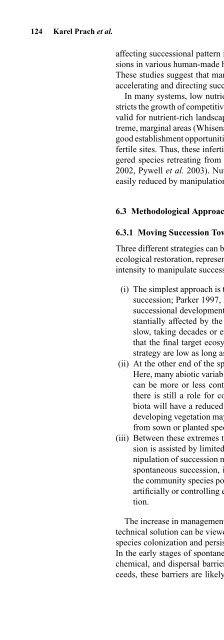Linking Restoration and Ecological Succession (Springer ... - Inecol
Linking Restoration and Ecological Succession (Springer ... - Inecol
Linking Restoration and Ecological Succession (Springer ... - Inecol
Create successful ePaper yourself
Turn your PDF publications into a flip-book with our unique Google optimized e-Paper software.
124 Karel Prach et al.<br />
affecting successional pattern in a comparative study of 15 unassisted successions<br />
in various human-made habitats in central Europe (Prach et al. unpubl.).<br />
These studies suggest that manipulation of soil pH might be a useful tool for<br />
accelerating <strong>and</strong> directing succession toward specific targets.<br />
In many systems, low nutrient availability assists restoration because it restricts<br />
the growth of competitive, nontarget species. This generalization appears<br />
valid for nutrient-rich l<strong>and</strong>scapes such as in temperate Europe, but not in extreme,<br />
marginal areas (Whisenant 1999). Low-fertility substrates often provide<br />
good establishment opportunities for those species that are weak competitors on<br />
fertile sites. Thus, these infertile sites can serve as refugia for rare <strong>and</strong> endangered<br />
species retreating from nutrient-enriched l<strong>and</strong>scapes (Benkewitz et al.<br />
2002, Pywell et al. 2003). Nutrient levels can be easily increased, but not so<br />
easily reduced by manipulation (Perrow <strong>and</strong> Davy 2002).<br />
6.3 Methodological Approaches<br />
6.3.1 Moving <strong>Succession</strong> Toward a Target<br />
Three different strategies can be envisaged for creating new ecosystems during<br />
ecological restoration, representing a gradient of management <strong>and</strong> intervention<br />
intensity to manipulate succession:<br />
(i) The simplest approach is to leave the site without intervention (unassisted<br />
succession; Parker 1997, Prach et al. 2001, Walker <strong>and</strong> del Moral 2003);<br />
successional development then proceeds at its own pace, but will be substantially<br />
affected by the local species pool. This strategy is sometimes<br />
slow, taking decades or even centuries, <strong>and</strong> it is often difficult to ensure<br />
that the final target ecosystem is met. However, costs to implement this<br />
strategy are low as long as no goods or services are affected.<br />
(ii) At the other end of the spectrum is a technical solution to reach a target.<br />
Here, many abiotic variables can be altered, <strong>and</strong> biota <strong>and</strong> biotic processes<br />
can be more or less controlled by introducing desirable species. While<br />
there is still a role for colonizing biota, it is likely that locally derived<br />
biota will have a reduced importance as establishment into developed or<br />
developing vegetation may be more difficult due to additional competition<br />
from sown or planted species.<br />
(iii) Between these extremes there is an approach where spontaneous succession<br />
is assisted by limited physical or biotic manipulations. Physical manipulation<br />
of succession may rely on improving the site <strong>and</strong> then allowing<br />
spontaneous succession, i.e., relying on colonization processes to create<br />
the community species pool. With biotic manipulation, adding some biota<br />
artificially or controlling established, nontarget species enhance colonization.<br />
The increase in management inputs moving from unassisted succession to a<br />
technical solution can be viewed as a sequential removal of barriers (filters) to<br />
species colonization <strong>and</strong> persistence (Temperton 2004; see Chapters 2 <strong>and</strong> 7).<br />
In the early stages of spontaneous succession there are a number of physical,<br />
chemical, <strong>and</strong> dispersal barriers to species establishment. As succession proceeds,<br />
these barriers are likely to decrease in importance <strong>and</strong> be replaced by

















